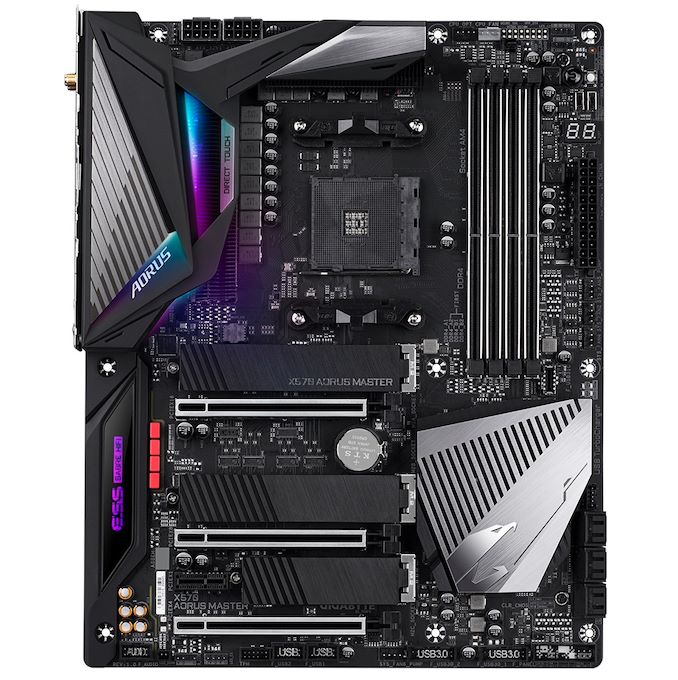The AMD X570 Motherboard Overview: Over 35+ Motherboards Analyzed
by Gavin Bonshor on July 9, 2019 8:00 AM ESTGIGABYTE X570 Aorus Master
Moving down the product stack from GIGABYTE's X570 SKU list is the GIGABYTE X570 Aorus Master which has a range of high-end features such as 2.5 Gigabit LAN, three PCIe 4.0 M.2 slots, and Intel's Wi-Fi 6 802.11ax wireless interface. The GIGABYTE X570 Aorus Master could be considered its flagship for general consumers without the hefty price tag attached to the higher grade X570 Aorus Extreme ($699).
Included is support for up to 128 GB of DDR4 memory across its four slots, with support for DDR4-4400 with three PCIe 4.0 x4 M.2 slots each with its own individual M.2 heatsink, and six SATA ports. There are three full-length PCIe 4.0 slots which operate at x16, x8/x8, and x8/x8/x4, with a single PCIe 4.0 x1 slot. On the power delivery front, GIGABYTE is using a formidable setup with a 12+2 design with power stages rated for 50 A, and with two 8-pin 12 V ATX CPU power inputs. The boards aesthetic is focused on the outer edges with a rear panel cover with RGB LEDs which stretches down to the audio PCB. For the X570 chipset, there's an actively cooled chipset heatsink which encompasses the Aorus Falcon into the design.
The onboard audio is handled by a Realtek ALC1220-VB HD audio codec and is complemented by an ESS Sabre 9118 DAC chip to enhance the auditory quality. This equates to five 3.5 mm audio jacks with a single S/PDIF optical output. Also on the rear panel is a Q-Flash Plus button for updating the firmware, a clear CMOS button, three USB 3.1 G2 Type-A, one USB 3.1 G2 Type-C, two USB 3.1 G1 Type-A and four USB 2.0 ports. The board's rear panel networking capabilities consist a Realtek RTL8125AG 2.5 G port with an assisting Intel Gigabit port for dual networking, as well as an Intel AX200 802.11ax Wi-Fi 6 wireless interface which also includes support for BT 5 devices.
GIGABYTE's X570 Aorus Master targets gamers and enthusiasts looking to push their processors further than the rated specifications, as well as offering 2.5 G and Wi-Fi 6 capable networking. The pricing reflects this with a price tag of $359 which puts it in the upper echelon of models, but the price seems fair all things considered.












225 Comments
View All Comments
abufrejoval - Tuesday, July 9, 2019 - link
It's amazing how quickly you run out of PCIe lanes, when you don't have switches to multiplex and translate between PCIe revisions and lanes (e.g. PCIe v4 x2 <-> PCIe v2 x8).I find myself using USB 3.x NBase-T NICs and NVMe adapters, simply because they *do* switch.
Bensam123 - Tuesday, July 9, 2019 - link
Maybe a bit more depth on the power delivery page. I have absolutely no idea how to go about parsing what's there. More chokes is better? What denotes a power phase?A5 - Tuesday, July 9, 2019 - link
+1. Some analysis of that information would be helpful.MrSpadge - Tuesday, July 9, 2019 - link
+1bunkle - Wednesday, July 10, 2019 - link
The controller column includes the total number of phases supported split between CPU cores and SoC e.g. (6+1) = 6 CPU phase and 1 SoC phase. More is *usually* better but has diminishing returns regarding tighter and tighter voltage regulation. Some controllers are better than others (can operate at high frequency e.g. 500KHz v 1000KHz, include other features to improve performance) mitigating the need for more phases.Each phase is a buck converter comprised of a low/high side MOSFET (can be integrated in a single package) and choke. Some controllers can support doubling up the PWM signal to driver more MOSFETs. Doublers can also be added as discrete components if not built into the controller.
Current rating of the MOSFET (e.g. Sic639=40A IR3555=60A) indicates the total power deliverable. MOSFETs are not 100% efficient and vary in efficiency. The more current they provide the hotter they get and the less efficient they become, with better MOSFETs producing less heat for a given current. Thus using doubles can improve temperatures and efficiency without the benefits of the tighter voltage tolerance that *real* phases provide.
Hope that’s helpful!
bunkle - Wednesday, July 10, 2019 - link
A lot more detailed explanation: https://en.wikichip.org/wiki/voltage_regulator_mod...bug77 - Tuesday, July 9, 2019 - link
The description for AsRock X570(M) Pro4 says "5 jack + 1 SPDIF". Unfortunately, those boards lack SPDIF and only come with 3 jacks ;)Smell This - Tuesday, July 9, 2019 - link
I'm thinking the *ASRock Thunderbolt AIC* ...https://thunderbolttechnology.net/product/asrock-t...
would cover all your TBT peripheral needs, including optical.
DanNeely - Tuesday, July 9, 2019 - link
Do X570 boards still need an extra chip per USB port to support USB-C reversibility?The additional expense and needed PCB space were cited as among the reasons why earlier generation boards (IIRC both Intel and AMD) almost never had more than 1 C port; but it was never clear to me if that was an inherent implementation penalty for the C port or an artifact of Intel's tech stack being stalled out and AMD outsourcing to ASMedia which built the chipsets on an ancient (55nm) platform.
DigitalFreak - Tuesday, July 9, 2019 - link
Gavin - X370 and X470 only supported PCIe 2.0. The connection between the CPU and chipset was 3.0, but all the ports on the chipset were 2.0.